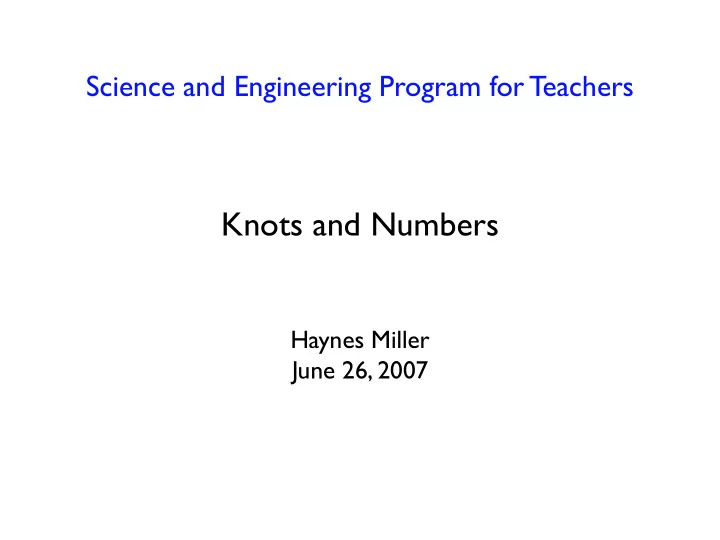

Science and Engineering Program for Teachers Knots and Numbers Haynes Miller June 26, 2007
Outline • Smoke rings and the Kelvin atom • Knots, prime and composite • Tangles, rational and irrational • A rope dance
Hermann von Helmholtz 1858: paper on “vortex rings” Also inventor of the ophthalmoscope, theories of vision and hearing, “Kelvin-Helmholtz instabilities”
Peter Guthrie Tait Scottish, hence interested in golf and quaternions (William Rowan Hamilton) Probably responsible for our use of i j k for unit basis vectors January, 1867: Demonstration of smoke rings
William Thomson, Lord Kelvin Knighted in 1866 for work on transatlantic cable 1867: “T&T” -- Treatise on Natural Philosophy Also: Thermodynamics (absolute temperature scale), practical electromagnetism
Hydrogen?
Hydrogen? Helium? Lithium?
H2 ?? Hydrogen? Helium? Lithium?
Census of prime knots crossings prime knots 3 1 4 1 5 2 6 3 7 7 8 21 9 49 10 165 11 552 12 2176 13 9988 14 46872 15 253293 (not counting mirror images)
Applications of Knot theory Biology: eg order Kinetoplastida packages its chromosomes in “chain mail” Physics: A knot is a configuration in the plane evolving through time. Feynman diagrams ... Mathematics: Major impact on Representation Theory and Category Theory
The “Perko pair” Kenneth Perko, 1974 (listed separately in knot tables since 1899)
John Conway 1967, “Tangles” Also Surreal Numbers, The Sensual (Quadratic) Form, Winning Ways for Your Mathematical Plays, The Monster group and monstrous moonshine
Thank you! Haynes Miller, hrm@math.mit.edu
Recommend
More recommend